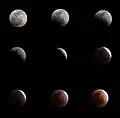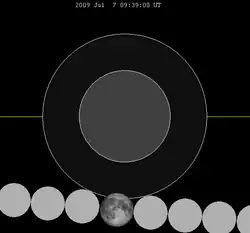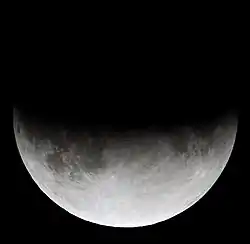| Total Lunar Eclipse 10 December 2011 | |
|---|---|
 Singapore, 14:40 UTC | |
 The Moon passes right to left through the Earth's shadow | |
| Series (and member) | 135 (23 of 71) |
| Gamma | -0.3882 |
| Magnitude | 1.1061 |
| Duration (hr:mn:sc) | |
| Totality | 0:51:08 |
| Partial | 3:32:15 |
| Penumbral | 5:56:21 |
| Contacts (UTC) | |
| P1 | 11:33:36 |
| U1 | 12:45:43 |
| U2 | 14:06:16 |
| Greatest | 14:31:49 |
| U3 | 14:57:24 |
| U4 | 16:17:58 |
| P4 | 17:29:57 |
 The Moon's hourly motion across the Earth's shadow in the constellation of Taurus | |
A total lunar eclipse took place on 10 December 2011. It was the second of two total lunar eclipses in 2011, the first having occurred on June 15. A lunar eclipse occurs when the Moon is positioned just right in its orbit to pass through Earth's shadow.
Visibility

Asia, Australia, and other areas of the Pacific had the best visibility. European countries only saw a partial eclipse of a rising moon, while northwestern North America saw a partial eclipse of a setting moon.
The eclipse was seen over the Philippines despite cloudy and rainy weather over parts of Luzon and other areas. Photos were taken by groups of amateur astronomers from the Astronomical League of the Philippines (ALP).
South America and portions of West Africa missed the eclipse completely as it happened in the early morning.


Gallery
Asia

- Japan


 Laguna, Philippines, 13:49 UTC
Laguna, Philippines, 13:49 UTC Bangkok, Thailand, 12:46-13:57 UTC
Bangkok, Thailand, 12:46-13:57 UTC.jpg.webp) Singapore, 14:10 UTC
Singapore, 14:10 UTC Lam Tin, Hong Kong, 14:47 UTC
Lam Tin, Hong Kong, 14:47 UTC Batticaloa, Sri Lanka, 15:07 UTC
Batticaloa, Sri Lanka, 15:07 UTC


 Japan
Japan
Australia and Oceania
Europe and Middle East
 End of Lunar Eclipse from the Netherlands, 12 images merged
End of Lunar Eclipse from the Netherlands, 12 images merged Modi'in, Israel.
Modi'in, Israel.
North America
 Peninsular Ranges of Southern California, just before moonset.
Peninsular Ranges of Southern California, just before moonset. Minneapolis, Minnesota, 13:05 UTC
Minneapolis, Minnesota, 13:05 UTC Loveland, Colorado, 13:49 UTC
Loveland, Colorado, 13:49 UTC Medford, Oregon, 14:34 UTC
Medford, Oregon, 14:34 UTC
Contact timing by location
Times for Australia
The eclipse occurred on Saturday evening in Australia. Eastern Daylight Saving Time: (+11:00 UTC)
- Penumbral Eclipse Begins: 22:33:32 EDST
- Partial Eclipse Begins: 23:45:42 EDST
- Total Eclipse Begins: 01:06:16 EDST
- Greatest Eclipse: 01:31:49 EDST
- Total Eclipse Ends: 01:57:24 EDST
- Partial Eclipse Ends: 03:17:58 EDST
- Penumbral Eclipse Ends: 04:30:00 EDST
Times for India
The eclipse was visible from India in the evening, given in India Standard Time (UTC+5:30):
- Penumbral eclipse begins (P1): 17:04 IST
- Partial eclipse begins (U1): 18:16 IST
- Total eclipse begins (U2): 19:36 IST
- Mid-eclipse: 20:02 IST
- Total eclipse ends (U3): 20:27 IST
- Partial eclipse ends (U4): 21:48 IST
- Penumbral eclipse ends (P4): 23:00 IST
Times for North America
The eclipse was visible on Saturday morning before sunrise over North America. For most location the moon set before full lunar eclipse. Only Alaska and northernmost Canada will be able to witness the entire event.
| Contact | North America | UTC | ||||
|---|---|---|---|---|---|---|
| AST (UTC−9) | PST (UTC−8) | MST (UTC−7) | CST (UTC−6) | EST (UTC−5) | ||
| Penumbral begins (P1) | 2:34 am | 3:34 am | 4:34 am | 5:34 am | 6:34 am | 11:34 |
| Partial begins (U1) | 3:46 am | 4:46 am | 5:46 am | 6:46 am | 7:46 am | 12:46 |
| Totality begins (U2) | 5:06 am | 6:06 am | 7:06 am | 8:06 am | 9:06 am | 14:06 |
| Mid-eclipse | 5:32 am | 6:32 am | 7:32 am | 8:32 am | 9:32 am | 14:32 |
| Totality ends (U3) | 5:57 am | 6:57 am | 7:57 am | 8:57 am | 9:57 am | 14:57 |
| Partial ends (U4) | 7:18 am | 8:18 am | 9:18 am | 10:18 am | 11:18 am | 16:18 |
| Penumbral ends (P4) | 8:30 am | 9:30 am | 10:30 am | 11:30 am | 12:30 pm | 17:30 |
| (Table entries are given a dark background for invisibility due to moonset) | ||||||
Related eclipses
Eclipses of 2011
- A partial solar eclipse on 4 January.
- A partial solar eclipse on 1 June.
- A total lunar eclipse on 15 June.
- A partial solar eclipse on 1 July.
- A partial solar eclipse on 25 November.
- A total lunar eclipse on 10 December.
It was preceded by the partial solar eclipse of November 25, 2011.
Half-Saros cycle
A lunar eclipse will be preceded and followed by solar eclipses by 9 years and 5.5 days (a half saros).[1] This lunar eclipse is related to two total solar eclipses of Solar Saros 142.
| 4 December 2002 | 14 December 2020 |
|---|---|
 |
 |
Lunar year (354 days)
This eclipse is the one of four lunar eclipses in a short-lived series. The lunar year series repeats after 12 lunations or 354 days (shifting back about 10 days in sequential years). Because of the date shift, the Earth's shadow will be about 11 degrees west in sequential events.
| Lunar eclipse series sets from 2009–2013 | ||||||||
|---|---|---|---|---|---|---|---|---|
| Ascending node | Descending node | |||||||
| Saros # Photo |
Date Viewing |
Type chart |
Gamma | Saros # Photo |
Date Viewing |
Type chart |
Gamma | |
| 110 | 2009 Jul 07 |
penumbral |
−1.4916 | 115 |
2009 Dec 31 |
partial |
0.9766 | |
120 |
2010 Jun 26 |
partial |
−0.7091 | 125 |
2010 Dec 21 |
total |
0.3214 | |
130 |
2011 Jun 15 |
total |
0.0897 | 135 |
2011 Dec 10 |
total |
−0.3882 | |
140 |
2012 Jun 04 |
partial |
0.8248 | 145 | 2012 Nov 28 |
penumbral |
−1.0869 | |
| 150 | 2013 May 25 |
penumbral |
1.5351 | |||||
| Last set | 2009 Aug 06 | Last set | 2009 Feb 9 | |||||
| Next set | 2013 Apr 25 | Next set | 2013 Oct 18 | |||||
See also
- List of lunar eclipses and List of 21st-century lunar eclipses
- December 2010 lunar eclipse
- June 2011 lunar eclipse
- File:2011-12-10 Lunar Eclipse Sketch.gif Chart
References
- ↑ Mathematical Astronomy Morsels, Jean Meeus, p.110, Chapter 18, The half-saros
External links
- 2011 Dec 10 chart: Eclipse Predictions by Fred Espenak, NASA/GSFC
- https://science.nasa.gov/science-news/science-at-nasa/2011/02dec_lunareclipse/
- Hermit eclipse: 2011-12-10
- NightSkyInfo.com : 10 December 2011 Lunar Eclipse
- ShadowAndSubstance.com Animation and time tables for US time zones
- Sharypic World Contributions Gallery
- SpaceWeather.com photo album
Live Webcasts
- Amateur Astronomers Association Delhi
- Astronomers Without Borders Archived 5 January 2012 at the Wayback Machine
- Live webcast of 10 Dec Lunar Eclipse
- Night Skies Networks
- Live webcast of 10 Dec Lunar Eclipse
- SEMS University of North Dakota SEMS project 3 minutes of totality from Grand Forks.
- SWAN from India.
- Live Webcast of 10 Dec Lunar Eclipse
- Lunar Eclipse over the Colorado Rocky Mountains


_(cropped).jpg.webp)
